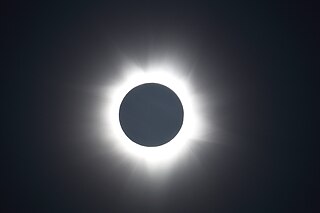| Solar eclipse of November 13, 2012 | |
|---|---|
 Totality as seen from Mount Carbine, Queensland | |
| Type of eclipse | |
| Nature | Total |
| Gamma | −0.3719 |
| Magnitude | 1.05 |
| Maximum eclipse | |
| Duration | 242 s (4 min 2 s) |
| Coordinates | 40°00′S 161°18′W / 40°S 161.3°W |
| Max. width of band | 179 km (111 mi) |
| Times (UTC) | |
| (P1) Partial begin | 19:37:58 |
| (U1) Total begin | 20:35:08 |
| Greatest eclipse | 22:12:55 |
| (U4) Total end | 23:48:24 |
| (P4) Partial end | 0:45:34 |
| References | |
| Saros | 133 (45 of 72) |
| Catalog # (SE5000) | 9536 |
A total solar eclipse occurred at the Moon's ascending node of orbit between Tuesday, November 13 and Wednesday, November 14, 2012,[1][2][3] with a magnitude of 1.05. A solar eclipse occurs when the Moon passes between Earth and the Sun, thereby totally or partly obscuring the image of the Sun for a viewer on Earth. A total solar eclipse occurs when the Moon's apparent diameter is larger than the Sun's, blocking all direct sunlight, turning day into darkness. Totality occurs in a narrow path across Earth's surface, with the partial solar eclipse visible over a surrounding region thousands of kilometres wide. Occurring about 12 hours before perigee (on November 14, 2012, at 10:20 UTC), the Moon's apparent diameter was larger.[4]
Because it crossed the International Date Line it began in local time on November 14 west of the date line over northern Australia, and ended in local time on November 13 east of the date line near the west coast of South America. Totality was visible from parts of Northern Australia. A partial eclipse was visible for parts of Australia, New Zealand, Oceania, West Antarctica, the Antarctic Peninsula, and southern South America.
- ^ "November 13–14, 2012 Total Solar Eclipse". timeanddate. Retrieved 12 August 2024.
- ^ "Aussies take in solar eclipse". Tulsa World. 2012-11-14. p. 6. Retrieved 2023-10-26 – via Newspapers.com.
- ^ "Thousands watch as solar eclipse casts long shadow". The Province. 2012-11-14. p. 34. Retrieved 2023-10-26 – via Newspapers.com.
- ^ "Moon Distances for London, United Kingdom, England". timeanddate. Retrieved 12 August 2024.
